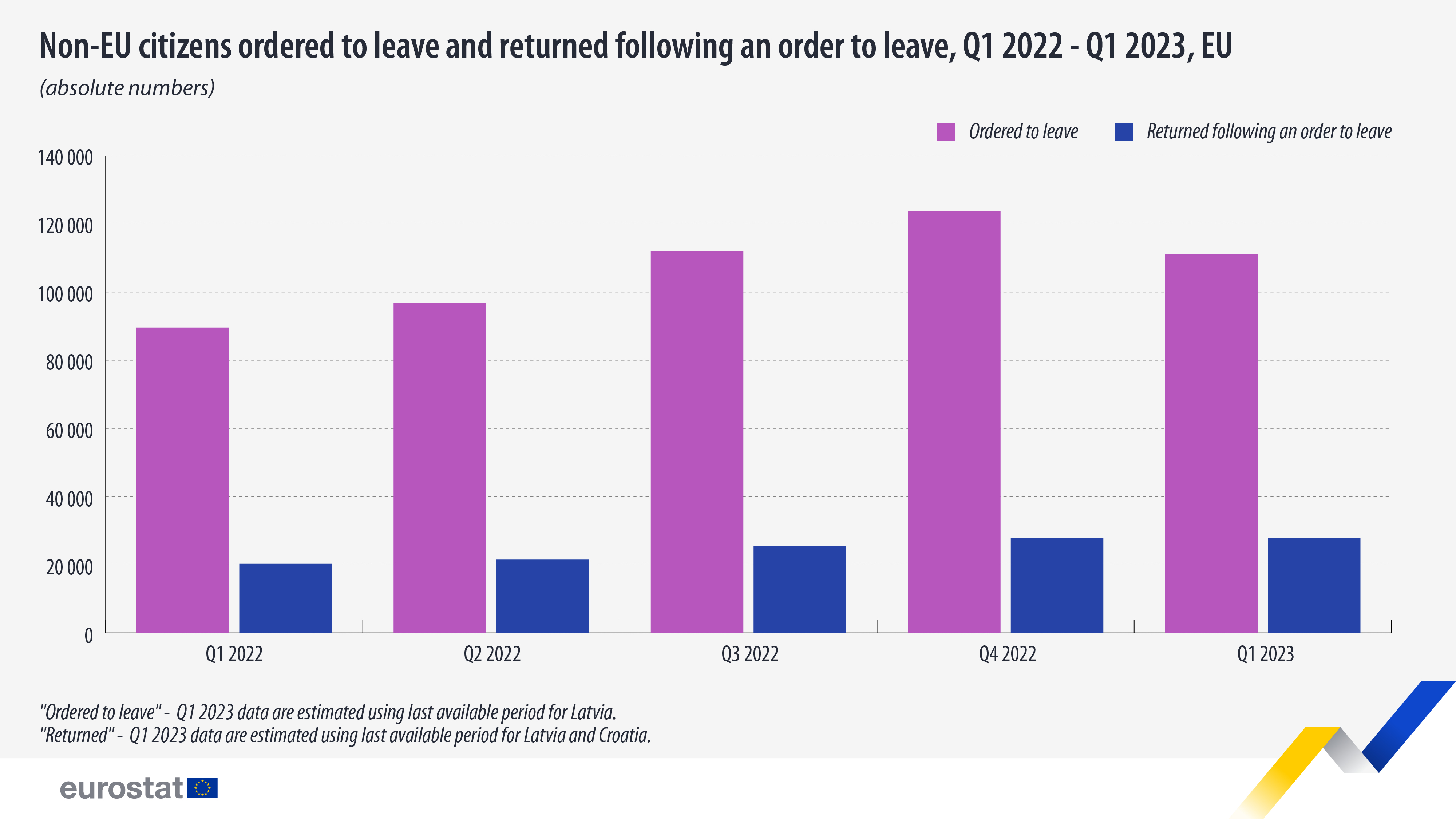Q1 2023: Returns up 37% from Q1 2022

In the first quarter of 2023, there were 27 880 non-EU citizens returned to another country (including to other EU countries) following an order to leave. Compared with the previous quarter (Q4 2022), returns increased, but only slightly by 0.4%, but if comparing with the same quarter of 2022, returns increased substantially by 37%.
In the same quarter, 111 275 non-EU citizens were ordered to leave an EU country, indicating a 10% decreased compared with Q4 2022. Compared with the same quarter of 2022, this number rose by 24%.
Source datasets: migr_eiord1, migr_eirtn1
15% of total returns in the EU reported by France
In the case of non-EU citizens returned to another country following an order to leave, France also reported the largest number of non-EU citizens returned in the first quarter of 2023, a total of 4 190, representing 15% of the total of returns. France was followed by Germany (3 355; 12%), the Netherlands (2 505; 9%), Sweden (2 380; 9%) and Cyprus (1 705; 6%).
Georgians (2 465) topped the list of non-EU citizens who returned to another country in the first quarter of 2023, followed by Indians (2 250), Albanians (1 875), Turks (1 365) and Moldovans (1 250).
Source datasets: migr_eiord1, migr_eirtn1
France: highest number of non-EU citizens ordered to leave
In the first quarter of 2023, among the EU countries, France reported the largest number of non-EU citizens ordered to leave its territory: 37 860 people, representing 34% of the total. France was followed by Germany (9 905), the Netherlands (7 500), Italy (6 920), Belgium (6 470) and Greece (6 350).
Compared with the last quarter of 2022, Hungary recorded the highest relative increase in the number of people ordered to leave (+178%), jumping from 625 to 1740.
In terms of citizenships of the people ordered to leave an EU country territory, Moroccans (9 500) represented the biggest share of the total (8.5%), followed by Algerians (9 275), Afghans (7 120), Indians (5 885) and Tunisians (5 245).
For more information
- Dedicated section on managed migration statistics
- Database on managed migration statistics
- Statistics Explained article on returns of irregular migrants - quarterly statistics
- Statistics Explained article on enforcement of immigration legislation statistics (yearly data)
- Statistics Explained article on enforcement of immigration legislation statistics methodology
Methodological notes
- Data presented in this news article and Statistics Explained article come from the new data collection launched in 2021, with Q1 2021 as the first reference period.
- A gap can be noted between the number of persons ordered to leave and the number of persons effectively returned, which can be explained mainly by an appeal of the decision, the procurement of a residence permit or the escape of the persons ordered to leave. More generally, some differences are also explained for administrative reasons, for example if a person is ordered to leave in December of year N, but returned in February of year N+1, or apprehended to be illegally present in year N, but granted asylum in year N+1. Due to differences in national administrative procedures in migration law enforcement and methodological aspects related to compilation of data in this area, the number of persons ordered to leave in a year shall not be directly related with the number of persons returned in the same reference period.
- Statistics on the enforcement of immigration legislation exclude outgoing asylum seekers who are transferred from one EU Member State to another under the mechanism established by the Dublin Regulation (Regulation (EC) No 1560/2003 and Regulation (EU) No 604/2013); these cases are covered by Dublin statistics.
If you have any queries, please visit our contact us page.


